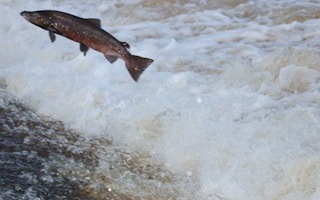Hydropower can dramatically alter rivers and destroy the habitat of migratory species such as salmon, but now scientists have shown that it is perfectly possible for rivers to produce more fish and more electricity at the same time.
After years of experience with hydro schemes in their own country, Norwegian scientists have produced a handbook to assist river engineers and to explain how to protect vulnerable species while exploiting rivers for renewable energy.
The Centre for Environmental Design of Renewable Energy (CEDREN) believes that by understanding the needs of migratory fish and controlling the flow of the river to accommodate their lifestyle, the breeding success can be improved. At the same time, by adapting and improving the turbine capacity and making it more flexible, more energy can be produced.
While the handbook is based on experience in Norway, the same principles can be applied to many rivers in mountainous areas that have salmon or other migratory fish. Some of the ideas might also apply to fast-flowing rivers in places such as the Himalayas, the European Alps, the Rockies in North America, and the Andes in South America.
There is resistance in many of these places to hydropower because it can cause drastic alteration to natural rivers and destroy their wildlife. As a result, there is still a large untapped potential for hydropower schemes in some regions.
Cheap and reliable
The handbook is intended as a blueprint to help engineers and environmentalists to work together to improve the habitat for wildlife, while extracting much-needed electricity from water power to help combat climate change. Hydropower is one of the cheapest and most reliable of renewables.
As far as salmon rivers are concerned, the handbook says the first task is to identify current problems that limit salmon production in rivers. These include lack of spawning grounds or shelter, low water periods, or periods of disadvantageous water temperature.
Looking at the existing or potential hydropower, engineers need to work out operating strategies for the power stations to avoid interfering with the salmon. These could include ideas such as transferring water from neighbouring rivers to improve flow at critical times, and increasing the capacity of turbines and waterways to make operation more flexible.
How the available water in the river is used is critical. Water flow to ensure environmental quality and water releases at different times of the year need to be closely regulated.
To achieve this, a flexible “water bank” will be required to ensure a good supply of water when needed. There also needs to be a smooth transition between high and low water flows, with some water being saved for critical periods.
Physical measures in the river might be needed, such as creating favourable gravel for spawning, restoring rapids and pool sequences in the river, creating shelter in the river bed as hiding-places for fish, and removing fine sediment that inhibits spawning.
Atle Harby, a senior research scientist, said that the new handbook – a world first of its type – can counter the current belief held by many that salmon inevitably suffer as a result of electric power generation in regulated rivers.
Harby heads the CEDREN research centre – one of Norway’s “national teams” in environmentally-friendly energy, and which is manned by scientists from SINTEF Energy Research, the Norwegian University of Science and Technology (NTNU) and the Norwegian Institute for Nature Research (NINA).
No contradiction
He said: “Increased hydropower generation and larger salmon stocks are not necessarily a contradiction in terms. We can use new knowledge and new methods to increase salmon production without compromising power production in many of the regulated rivers. And this can be done using measures that don’t necessarily require major investments.
“It won’t be possible everywhere, and in some rivers we have still to choose between salmon and power. But it is quite possible in many important salmon rivers to produce more salmon while maintaining existing power generation. We believe that our conclusions will be valid for a good number of important highly-regulated rivers.
“We hope that the handbook will be used to identify what will be possible in each individual river.”
Torbjørn Forseth, a senior scientist at NINA, said that salmon is an important indicator species in rivers. If salmon are doing well, and reproduce and thrive as they should, then other aspects of the river’s ecological system are also probably functioning well.
Many of the handbook’s recommendations do not cost money. Much can be achieved by concentrating releases of water down the river during periods that are important for the salmon’s living conditions. Water temperature, riverbed structures and habitat conditions are important for the salmon and vary from year to year, but can be monitored and improved by river management.
Forseth added that while transfer of water from neighbouring rivers can be costly, it is another possible option to ensure that hydropower companies and salmon have more water to share.










